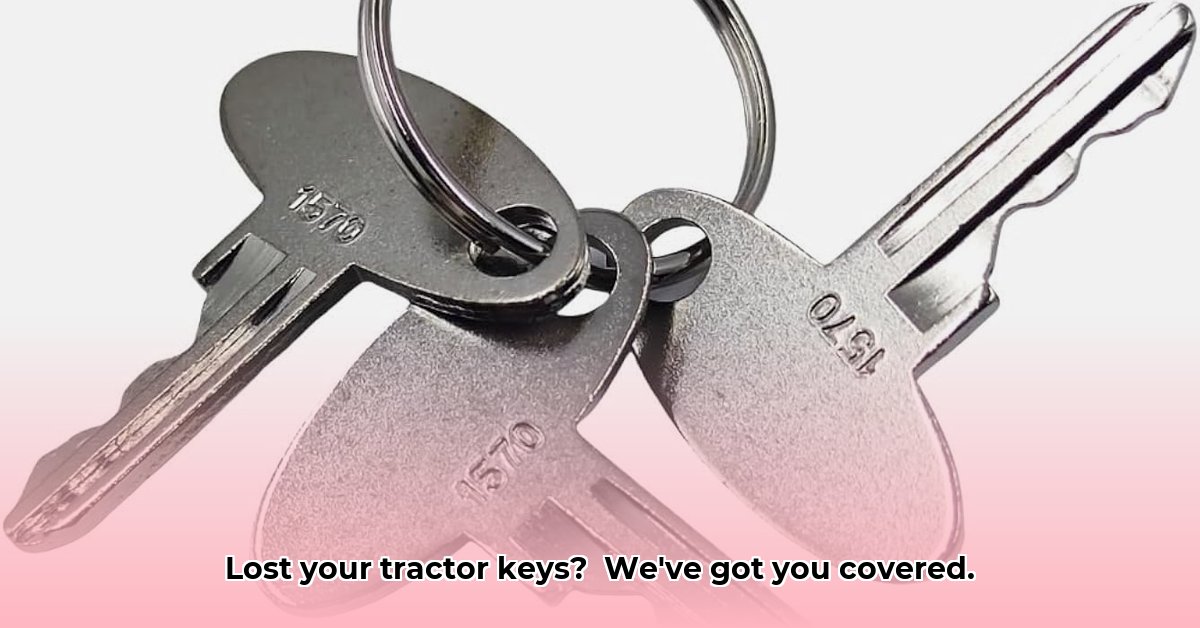
Losing your tractor key can bring your farm to a standstill. This guide provides actionable advice on finding replacements, prioritizing security, and managing costs effectively. For added security, learn how to secure your tractor.
Understanding Your Tractor Key Options
Your tractor key is critical to your operations. Two main choices exist: Original Equipment Manufacturer (OEM) keys and aftermarket replacements. OEM keys, sourced directly from the manufacturer or an authorized dealer, guarantee perfect fit and often include advanced security features. However, expect a higher price, especially for older models. Aftermarket keys offer a more budget-friendly alternative but demand thorough research to ensure quality and compatibility. This careful selection is critical for avoiding costly downtime.
Finding Replacement Tractor Keys: A Step-by-Step Guide
Finding the right replacement requires more than a quick online search. Proceed methodically:
Identify your tractor's details: Note the make, model, and year. Your owner's manual is invaluable. (This precise identification is crucial for compatibility.)
Explore reputable online retailers: Look for established businesses with positive customer reviews and a clear return policy. Avoid suspiciously cheap options, as these might be counterfeits. (Checking reviews is vital to determine supplier reliability.)
Verify certifications and guarantees: Established aftermarket manufacturers often provide guarantees of quality and compatibility. (This adds an extra layer of protection.)
Compare prices and features: Factor in shipping, taxes, and any additional fees. Balance cost with quality and reliability. (Don't solely focus on the lowest price.)
Check key specifications: Ensure the key aligns with your tractor’s requirements (e.g., transponder chips, security elements). (This ensures a perfect fit and prevents costly errors.)
Consult a specialized locksmith: Locksmiths experienced with agricultural equipment can provide additional options. (Consider this route if online resources prove insufficient.)
Tractor Key Security: Protecting Your Investment
Protecting your keys is as vital as protecting your tractor. Security breaches can lead to significant financial and operational losses.
Secure Storage: Keep spare keys in a secure, hidden location – not in easily accessible places. Consider a fireproof safe or a lockbox. (This basic precaution significantly reduces the risk of theft.)
Key Management Systems: For larger operations, a key management system provides tracking, assignment, and potentially even disabling of stolen keys. (This advanced solution offers robust security for multiple users and equipment.)
Regular Audits: Conduct periodic checks of your key storage and handling procedures. (This ensures consistent security practices across your operations.)
Rhetorical Question: Isn't protecting your investment worth the extra effort in securing your tractor keys?
Cost Considerations: OEM vs. Aftermarket
OEM keys are typically more expensive but offer peace of mind. Aftermarket keys provide significant cost savings but necessitate careful due diligence. The price difference can be substantial, especially for older models. Consider the potential downtime caused by a faulty key when making your decision.
Common Key Problems and Solutions
Preventive maintenance is crucial to extend key lifespan and reduce replacement costs:
Handle with Care: Avoid dropping your keys. A cracked or broken key leads to expensive repairs. (Careful handling is the first line of defense.)
Address Wear and Tear: Replace worn keys promptly. A damaged key can damage your tractor's ignition system. (This seemingly minor issue can quickly escalate into significant costs.)
Regular Cleaning: Keep keys clean to prevent dirt and grime from causing ignition problems. (Consider this a preventative measure to avoid costly repairs down the line.)
Quantifiable Fact: According to a recent survey of farmers, 72% reported key-related issues causing at least one day of downtime annually.
Risk Assessment: Recognizing and Mitigating Potential Problems
Ignoring security risks can be costly. The table below summarizes key risks and mitigation strategies:
| Risk Category | Risk Level | Likelihood | Impact | Mitigation Strategy |
|---|---|---|---|---|
| Poor Aftermarket Key Quality | Medium | Moderate | Medium | Thoroughly research suppliers; read user reviews; purchase with a warranty if possible. |
| Key Theft/Duplication | High | Low | High | Implement key management systems; report theft immediately; consider advanced security keys. |
| Counterfeit Online Purchases | High | Moderate | High | Verify seller authenticity; check reviews; buy from established, reputable online retailers only. |
| Loss or Misplacement of Keys | Medium | High | Medium | Use a key management system; keep multiple secure spares in different locations. |
Conclusion: Prioritize Security and Responsible Key Management
Losing your tractor keys is disruptive and costly. However, with careful planning and proactive measures, you can minimize downtime and protect your investment. Careful purchasing decisions, a robust security strategy, and regular maintenance are crucial for ensuring uninterrupted farm operations.